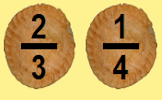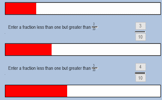












Not so fast with the clicking!
That is not the next smallest number.
Drag and DropCheese and Onion Pies Arrange the fractions in order from smallest to largest. |
Well Done! |
A ChallengeVinculum Find fractions larger than the previous fraction but less than one. |
This is Fraction Lines level 1. You can also try:
Level 2
Level 3
Level 4
Level 5
Level 6
Level 7
InstructionsTry your best to answer the questions above. Type your answers into the boxes provided leaving no spaces. As you work through the exercise regularly click the "check" button. If you have any wrong answers, do your best to do corrections but if there is anything you don't understand, please ask your teacher for help. When you have got all of the questions correct you may want to print out this page and paste it into your exercise book. If you keep your work in an ePortfolio you could take a screen shot of your answers and paste that into your Maths file. |
||
|
|
||
|
|

|
More Activities: |
|
Mathematicians are not the people who find Maths easy; they are the people who enjoy how mystifying, puzzling and hard it is. Are you a mathematician? Comment recorded on the 25 June 'Starter of the Day' page by Inger.kisby@herts and essex.herts.sch.uk, : "We all love your starters. It is so good to have such a collection. We use them for all age groups and abilities. Have particularly enjoyed KIM's game, as we have not used that for Mathematics before. Keep up the good work and thank you very much Comment recorded on the 28 May 'Starter of the Day' page by L Smith, Colwyn Bay: "An absolutely brilliant resource. Only recently been discovered but is used daily with all my classes. It is particularly useful when things can be saved for further use. Thank you!" |
Each month a newsletter is published containing details of the new additions to the Transum website and a new puzzle of the month. The newsletter is then duplicated as a podcast which is available on the major delivery networks. You can listen to the podcast while you are commuting, exercising or relaxing. Transum breaking news is available on Twitter @Transum and if that's not enough there is also a Transum Facebook page. |
|
AnswersThere are answers to this exercise but they are available in this space to teachers, tutors and parents who have logged in to their Transum subscription on this computer. A Transum subscription unlocks the answers to the online exercises, quizzes and puzzles. It also provides the teacher with access to quality external links on each of the Transum Topic pages and the facility to add to the collection themselves. Subscribers can manage class lists, lesson plans and assessment data in the Class Admin application and have access to reports of the Transum Trophies earned by class members. If you would like to enjoy ad-free access to the thousands of Transum resources, receive our monthly newsletter, unlock the printable worksheets and see our Maths Lesson Finishers then sign up for a subscription now: Subscribe |
||
Go MathsLearning and understanding Mathematics, at every level, requires learner engagement. Mathematics is not a spectator sport. Sometimes traditional teaching fails to actively involve students. One way to address the problem is through the use of interactive activities and this web site provides many of those. The Go Maths page is an alphabetical list of free activities designed for students in Secondary/High school. Maths MapAre you looking for something specific? An exercise to supplement the topic you are studying at school at the moment perhaps. Navigate using our Maths Map to find exercises, puzzles and Maths lesson starters grouped by topic. | ||
Teachers | ||
|
If you found this activity useful don't forget to record it in your scheme of work or learning management system. The short URL, ready to be copied and pasted, is as follows: |
Alternatively, if you use Google Classroom, all you have to do is click on the green icon below in order to add this activity to one of your classes. |
It may be worth remembering that if Transum.org should go offline for whatever reason, there is a mirror site at Transum.info that contains most of the resources that are available here on Transum.org. When planning to use technology in your lesson always have a plan B! |
|
|
||
© Transum Mathematics 1997-2025
Scan the QR code below to visit the online version of this activity.
https://www.Transum.org/go/?Num=44
Close

Level 1 - Fractions represented as pie charts
Level 2 - Tenths represented as a grid of squares
Level 3 - Decimal fractions some with hundredths
Level 4 - Twelfths represented as a grid of squares
Level 5 - Vulgar fractions simplified twelfths
Level 6 - Mixed fraction pictures
Level 7 - Mixed fractions and decimals
More on this topic including lesson Starters, visual aids, investigations and self-marking exercises.
Answers to this exercise are available lower down this page when you are logged in to your Transum account. If you don’t yet have a Transum subscription one can be very quickly set up if you are a teacher, tutor or parent.
See the National Curriculum page for links to related online activities and resources.
Order these fractions from smallest to largest
$$ \frac{3}{4} , \frac{7}{8} , \frac{1}{2} , \frac{1}{4} , \frac{3}{8} $$Method 1: Write each of the fractions with a common denominator. The lowest common multiple of the five denominators is 8 so the five fractions become:
$$ \frac{6}{8} , \frac{7}{8} , \frac{4}{8} , \frac{2}{8} , \frac{3}{8} $$It is now easy to order the fractions in order of their denominators:
$$ \frac{2}{8} , \frac{3}{8} , \frac{4}{8} , \frac{6}{8} , \frac{7}{8} $$Now write each of these fractions in the way they were written in the question:
$$ \bbox[yellow,5px,border:2px solid red]{ \frac{1}{4} ,\quad \frac{3}{8} ,\quad \frac{1}{2} ,\quad \frac{3}{4} ,\quad \frac{7}{8} }$$Method 2: Convert each of the fractions to decimals (to three decimal places for this example) by dividing the numerators by the denominators:
$$ \require{enclose} \begin{array}{r} 0.750 \\[-3pt] 4 \enclose{longdiv}{3.000} \\[-3pt] \end{array} , \require{enclose} \begin{array}{r} 0.875 \\[-3pt] 8 \enclose{longdiv}{7.000} \\[-3pt] \end{array} , \require{enclose} \begin{array}{r} 0.500 \\[-3pt] 2 \enclose{longdiv}{1.000} \\[-3pt] \end{array} , \require{enclose} \begin{array}{r} 0.250 \\[-3pt] 4 \enclose{longdiv}{1.000} \\[-3pt] \end{array} , \require{enclose} \begin{array}{r} 0.375 \\[-3pt] 8 \enclose{longdiv}{3.000} \\[-3pt] \end{array} $$The decimal equivalents can more easily be ordered then writen in the way they were written in the question to give the same answer as method 1.
Answers to this exercise are available lower down this page when you are logged in to your Transum account. If you don’t yet have a Transum subscription one can be very quickly set up if you are a teacher, tutor or parent.
Close
